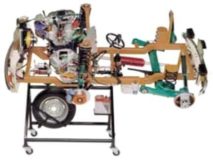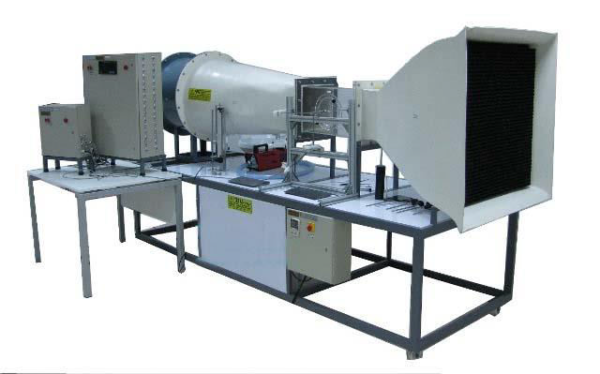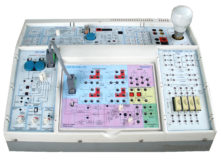Open Wind Tunnel - Subsonic Model AT 002
Home » Products » Open Wind Tunnel – Subsonic Model AT 002
Open Wind Tunnel – Subsonic Model AT 002
Sci-tech Open Wind Tunnel – Subsonic Model AT 002 setup is an open wind tunnel used to demonstrate and measure the aerodynamic properties of various models. For this purpose, air is drawn in from the environment and accelerated. The air flows around a model, such as an aero foil, in a measuring section. The air is then decelerated in a diffuser and pumped back into the open by a fan.
The carefully designed nozzle and a flow straightener ensure a uniform velocity distribution with little turbulence in the closed measuring section. The flow cross section of the measuring section is square. The built-in axial fan and a variable-speed drive is characterized by an energy-efficient operation at high efficiency. Air velocities of up to 30 m/s can be reached in this open wind tunnel. The air velocity in the measuring section is displayed on the inclined tube manometer.
Extensive accessories allow a variety of experiments, for example lift measurements, pressure distributions, boundary layer analysis.
| Size: | 350cm x 80cm x 85cm (LxWxH) |
| Weight: | 230 kg |
Item Description
Features
- Open wind tunnel for a variety of aerodynamic experiments
- Homogeneous flow through the flow straightener and special nozzle section
- Transparent test section
- Experiments from the field of aerodynamics and fluid mechanics with an “Eiffel” type wind tunnel
- Wide range of accessories available
- Transparent, closed measuring section
- Inlet contour, nozzle and diffuser made of FRP
- Variable‐speed fan motor for energy‐efficient operation
- Flow straightener reduces turbulence
- Electronic two‐component force sensor for measuring the flow forces
- Inclined tube manometer for displaying the air velocity
- Digital display of drag and lift
- Comprehensive selection of optional instrumentation, models and accessories.
- High Speed Data Acquisition System for computer control of wind tunnel & measurement of parameters like Pressure distribution, Lift & Drag Forces, Velocity & Angle of attack.
Sci-tech Open Wind Tunnel – Subsonic Model AT 002 setup is an open wind tunnel used to demonstrate and measure the aerodynamic properties of various models. For this purpose, air is drawn in from the environment and accelerated. The air flows around a model, such as an aero foil, in a measuring section. The air is then decelerated in a diffuser and pumped back into the open by a fan.
The carefully designed nozzle and a flow straightener ensure a uniform velocity distribution with little turbulence in the closed measuring section. The flow cross section of the measuring section is square. The built-in axial fan and a variable-speed drive is characterized by an energy-efficient operation at high efficiency. Air velocities of up to 30 m/s can be reached in this open wind tunnel. The air velocity in the measuring section is displayed on the inclined tube manometer.
Extensive accessories allow a variety of experiments, for example lift measurements, pressure distributions, boundary layer analysis.
Optional data acquisition system has been developed specifically to support the analysis of experiments with the wind tunnel. Data Acquisition System consists of an interface module for sensors used with Subsonic Wind Tunnel. The system supports experiments such as measurement of lift and drag on drag bodies, pressure distribution on an aero foil or a cylinder. Therefore, depending on the experiments, pressure sensors, angle sensors and the electronic displacement measurement and the three-component force sensor can be connected to the interface module.
Velocity, pressure, angle of attack or displacement and lift and drag forces are transmitted via USB directly to an integrated PC where they can be analyzed using the ‘Sci-Cal’ software.
See also different:

Sci-tech Automotive Sectioned Structure Educational System of a Petrol Car Model AM 09 demonstrates the inter-relationship between components of an actual car. The training model is built with the original automotive parts, fitted on a frame s [...]



